 Shooting vittles can be as complex as you want to make it. But it is pretty easy to get elegant, well-lit food photographs with almost no money out of pocket.
Shooting vittles can be as complex as you want to make it. But it is pretty easy to get elegant, well-lit food photographs with almost no money out of pocket. Hit the jump for a gastronomic update on a Strobist cheapskate classic.
__________
Of the 1,000+ posts on Strobist at this writing, one of the most popular is the $10 Macro Studio -- a cardboard box hack that makes it almost impossible to take a bad shot of a small object.
With a little alteration, that same concept can be used to create classic food photography lighting with a light source as simple as a desk lamp. Of course, a speedlight will work great, too...
Thinking Outside of the Box
The classic direction for lighting food is from the top/back. In typical presentation, food has more width and depth than it does height. So the top/back is a logical position from which light can rake across the food to reveal texture and form.
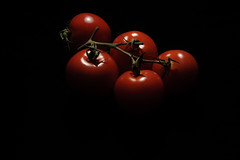 For this walk-through I raided the fridge for some fresh tomatoes. Not complex, but nice and 3-d for illustrative purposes. Here they are with a bare light hitting them from the classic, top/back position.
For this walk-through I raided the fridge for some fresh tomatoes. Not complex, but nice and 3-d for illustrative purposes. Here they are with a bare light hitting them from the classic, top/back position.This hard light almost makes the 'maters look as if they are made of wood and painted glossy red. You can do a lot to manipulate the visual perception of surface quality with different lighting techniques.
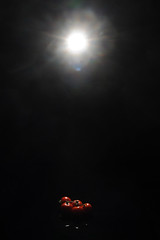 Here is the same shot with a wider lens. The light source is a bare SB-800, but it could just as easily be a desk lamp.
Here is the same shot with a wider lens. The light source is a bare SB-800, but it could just as easily be a desk lamp. You could easily soften that light with an umbrella if you have one. But if your food or setting is specular, those ribs (Mmm-hmm-hmm-hmm... ribs...) are gonna give you problems.
This is one of those instances where a soft box is much better than a shoot-through. But there is no need to shell out for one if you are not shooting this kind of stuff all of the time.
Instead, you can hack a large cardboard box (quite literally) and essentially turn the soft box inside out.
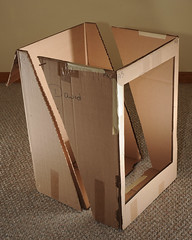 So, here is the basic box -- use a big one -- cut up and placed back together to give you a sense of where the cuts are. The more of an angle you put on that diagonal cut, the more your light will come from the back. I did this one kinda middle-of-the-road, but you might want to crank it up a notch or two.
So, here is the basic box -- use a big one -- cut up and placed back together to give you a sense of where the cuts are. The more of an angle you put on that diagonal cut, the more your light will come from the back. I did this one kinda middle-of-the-road, but you might want to crank it up a notch or two.And if you use a razor knife like I did, please be careful. Or at least bookmark this page before you start. Just sayin'.
(LIGHTING GEEK NOTE: I had fun doing a quickie shot of the cut-up cardboard box. Click it to see bigger, with notes on the locations of the four flashes involved ...)
That big open square on the top is gonna get some diffusion material, so the window will do its job and improve your harsh light source. Tracing paper is ideal, but tissue paper (big, like from a gift) works great. Stretch it smooth. Wax paper will do in a pinch, too.
I scrounged a little Rosco Tuff Frost, which is tough (duh) and uniform, not to mention color-neutral. That last part is important, if you are using some type of mystery diffusor.
Also, if you are using this with a desk lamp, use an incandescent bulb (no CFLs) and set your camera's white balance to tungsten. Everything will work fine.
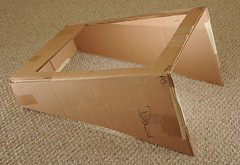 Here is the part you keep, and by now it should be getting pretty self explanatory as to how to use it to soften that bare flash or desk lamp. If you are more of a food blogger than a photographer, you can do this all with continuous light and a tripod -- just crank that aperture wayyy down for lots of depth of field.
Here is the part you keep, and by now it should be getting pretty self explanatory as to how to use it to soften that bare flash or desk lamp. If you are more of a food blogger than a photographer, you can do this all with continuous light and a tripod -- just crank that aperture wayyy down for lots of depth of field.(Not that this is a foodie blog, but you regulars would be surprised at who passes through here while learning to shoot stuff for their site.)
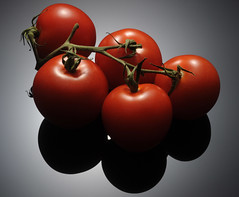 Okay, so lets stick our box in between the light and the subject and see what happens. Right away, the tomatoes look way better. I am using a sheet of black plexi as a background, to get a clean reflection of the new, slicker light source. (The umbrella would suck for this background, because of the ribs' reflection.)
Okay, so lets stick our box in between the light and the subject and see what happens. Right away, the tomatoes look way better. I am using a sheet of black plexi as a background, to get a clean reflection of the new, slicker light source. (The umbrella would suck for this background, because of the ribs' reflection.)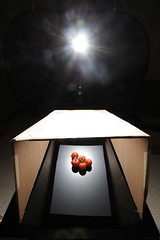 Here is a pullback, which actually is a pretty cool composition. But looking at this (and the photo just above) our next problem is that the bottoms of the tomatoes are too dark. This is because all of the light is coming from the back/top.
Here is a pullback, which actually is a pretty cool composition. But looking at this (and the photo just above) our next problem is that the bottoms of the tomatoes are too dark. This is because all of the light is coming from the back/top.That's an easy fix, and we do not need another light, either. We can get double-duty out of our nice main light by adding a reflector:
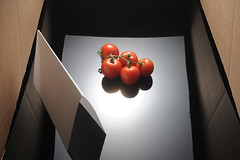 Since this is a no-wallet Monday, let's fix this with a folded sheet of printer paper (or, if you are over 50, typing paper...) Just fold it and stand it in front of the tomatoes -- maybe to one side, as shown. (You could stick it right in front, too for a different look.)
Since this is a no-wallet Monday, let's fix this with a folded sheet of printer paper (or, if you are over 50, typing paper...) Just fold it and stand it in front of the tomatoes -- maybe to one side, as shown. (You could stick it right in front, too for a different look.)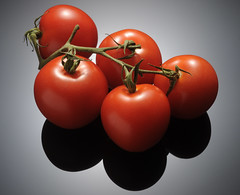 As you can now see, that one sheet of paper makes a huge difference.
As you can now see, that one sheet of paper makes a huge difference. By default, it will not overpower the main light source, either. It's a reflector, and cannot give out more light than it is receiving.
 So, let's try another reflector on the other side. It may be that the second reflected light source ends up being too much. But at two cents a pop, go for it and see what happens.
So, let's try another reflector on the other side. It may be that the second reflected light source ends up being too much. But at two cents a pop, go for it and see what happens.Here it is close-up, which is the same photo at the top of the post. Maybe you like the extra detail, or maybe the second highlight turns you off. That's up to you -- add salt to taste.
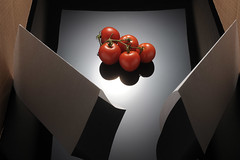 Here is a pullback with two reflectors for clarity's sake. Depending on the topography of what you are shooting, these reflectors do not need to be big, or symmetrical -- or even white. You can illuminate those shadows exactly the way you want by placing as many reflectors -- large and/or small -- wherever you want.
Here is a pullback with two reflectors for clarity's sake. Depending on the topography of what you are shooting, these reflectors do not need to be big, or symmetrical -- or even white. You can illuminate those shadows exactly the way you want by placing as many reflectors -- large and/or small -- wherever you want.Need more light? Try aluminum foil reflectors. That's what I used for this cake. Crinkle it up, then straighten it back out for a nice, smooth, pebbled reflector surface. You can choose the shiny or matte surface, too, for different looks.
 Here it is, from the side angle.
Here it is, from the side angle. Again, that SB-800 flash could easily be a desk or floor lamp. And the grey backdrop was just to hide the white wall reflection in the initial shot. Once you get the diffusor panel up, that problem solves itself.
__________
Fast Food
So, there you go -- an easy entré into food photography. If this kind of thing floats your boat, you might want to consider a medium-sized soft box, which will of course make this kind of light very easy. And it travels well, too.
If you're a food blogger and you decide to play with it, link in and spread the luv -- and post a comment so we can see what a hotshot food photographer you are now...
Không có nhận xét nào:
Đăng nhận xét